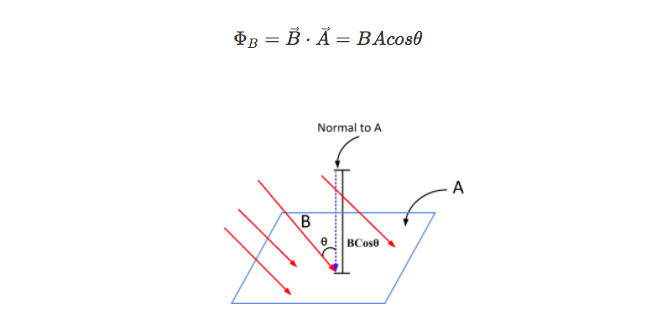Key Concepts of Faraday's Law of Induction to Know in AP Physics C: E&M (2025)
Electromagnetic induction
is the process of using shifting magnetic fields to generate electric current.
This phenomenon is explained by Faraday's Law, which states that the rate at which magnetic flux changes via a circuit determines the induced electromotive force (emf).
Faraday's Law, which measures the induced electromotive force (EMF), and Lenz's Law, which establishes the direction of the induced current, are included in this AP Physics topic.
In order to solve relevant problems on the AP Physics exam and to understand its numerous practical applications, such as generators and transformers, it is important to understand these laws.
Magnetic Flux
Many different physics ideas can be described with the use of the concept of flux. Here, it will be used to describe magnetic fields; if you take AP C: E&M, it is also used to describe electric fields.
In essence, flux indicates the amount of anything that passes through a specific area.
Consider an area on a magnetized object's surface. Whatever the object is, it makes no difference. The number of magnetic field lines that traverse the area is then used to characterize the magnetic flux (ΦB).
Since it makes the math easier, it is typically defining the area that happens to be parallel to the magnetic field. If it isn't possible, we calculate the flux by taking the dot product of the area vector and the magnetic field.

A is the area through which we are measuring the flux, B is the strength of the magnetic field, and θ is the angle formed between the area vector and the magnetic field vector. The flux would be Tm^2, which is equal to a Weber (Wb), according to the units for the flux.
Faraday’s Law of Electromagnetic Induction
is a physics principle that explains how an electric current generated by a conductor is related to a changing magnetic field. It asserts that the rate at which the magnetic flux changes through a conductor is equal to the induced electromotive force (emf) in that conductor.
A key idea in electromagnetism, Faraday's law of induction is utilized to comprehend and examine how induced currents behave in electrical and electronic circuits. It is a helpful tool for predicting how electrical and electronic circuits and devices will function.
Formula

Where:
E = induced EMF (volts)
ΦB = magnetic flux (weber, Wb)
dΦ/dt = rate of change of magnetic flux
The foundation of Faraday's law of induction is the idea that an electromotive force (emf) will be induced in a conductor by a changing magnetic field. The rate at which the magnetic flux changes through the conductor is the same as the induced emf.
Induced EMF: An EMF is created when a circuit's magnetic flux changes. This could be because the circuit is moving through a magnetic field, the magnetic field is changing, or the circuit is deforming.
Important Points
Because Faraday's Law has a negative sign, a positive rate of change in magnetic flux causes a negative EMF (opposite direction).
The induced EMF increases with the rate of change in magnetic flux.
Lenz’s Law
Formula

Where:
Emf = the induced voltage (also known as electromotive force).
N = the number of loops.
△Φ = Change in magnetic flux.
△t = Change in time.
addresses the Faraday's Law negative sign. It allows us to determine the direction of the induced current in addition to providing the direction of the induced EMF.
In its most basic form, Lenz's Law states that the induced electromagnetic field (EMF) in a wire or loop will always be the opposite of the change in magnetic flux that caused it.
The Law of Conservation of Energy provides the fundamental justification for this. It would begin a positive feedback loop that would generate unlimited EMF (and infinite energy) if the generated EMF was pointing in the same direction as the flux.
Application
The induced current in a coil produces a magnetic field that opposes the motion of a magnet when it is moved in its direction.
The induced current produces a magnetic field that tries to hold the magnet close when it moves away.
Lenz's Law and Faraday's Law combined
For example: Observing a wire loop in a changing magnetic field.
Increasing Magnetic Field
According to Faraday's Law, an induced electromagnetic field will occur if the magnetic field flowing through the loop increases.
Lenz's Law states that the induced current will flow in a way that opposes the rise by producing a magnetic field.
Decreasing Magnetic Field
In the event that the magnetic field decreases, the induced electromagnetic field will provide a current that counteracts the decreasing magnetic field.
Real-World Applications
Electric Generators
Generators use electromagnetic induction to convert mechanical energy into electrical energy.
An electric current is created when a coil rotates in a magnetic field because of the changing magnetic flux, which induces an EMF.
Transformers
Transformers transfer electrical energy between circuits by means of electromagnetic induction.
An EMF is induced in the secondary coil by a changing magnetic flux caused by a changing current in the primary coil.
Induction Cooktops
Induction cooktops use electromagnetic induction to heat pots and pans.
A changing magnetic field produced by an alternating current in a coil underneath the cooktop causes currents to flow through the metal cookware, which heats up as a result of electrical resistance.
 Knowt
Knowt
